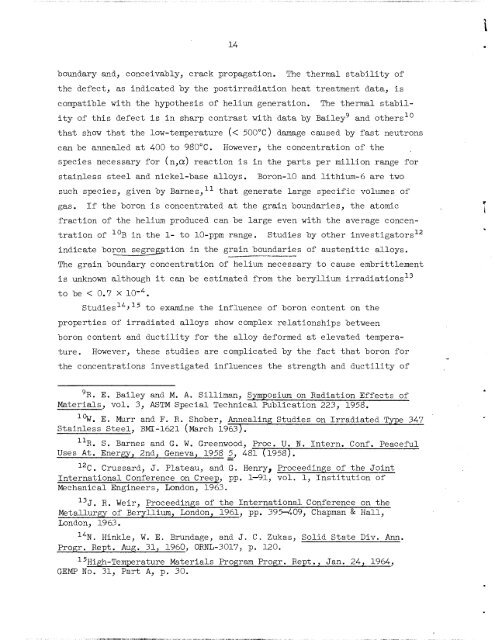Effect of Elevated Temperature Irradiation on the Strength and ...
Effect of Elevated Temperature Irradiation on the Strength and ...
Effect of Elevated Temperature Irradiation on the Strength and ...
Create successful ePaper yourself
Turn your PDF publications into a flip-book with our unique Google optimized e-Paper software.
14<br />
boundary <strong>and</strong>, c<strong>on</strong>ceivably, crack propagati<strong>on</strong>. The <strong>the</strong>rmal stability <str<strong>on</strong>g>of</str<strong>on</strong>g><br />
<strong>the</strong> defect, as indicated by <strong>the</strong> postirradiati<strong>on</strong> heat treatment data, is<br />
compatible with <strong>the</strong> hypo<strong>the</strong>sis <str<strong>on</strong>g>of</str<strong>on</strong>g> helium generati<strong>on</strong>. The <strong>the</strong>rmal stabil<br />
ity <str<strong>on</strong>g>of</str<strong>on</strong>g> this defect is in sharp c<strong>on</strong>trast with data by Bailey9 <strong>and</strong> o<strong>the</strong>rs10<br />
that show that <strong>the</strong> low-temperature (< 500°C) damage caused by fast neutr<strong>on</strong>s<br />
can be annealed at 400 to 980°C. However, <strong>the</strong> c<strong>on</strong>centrati<strong>on</strong> <str<strong>on</strong>g>of</str<strong>on</strong>g> <strong>the</strong><br />
species necessary for (n,a) reacti<strong>on</strong> is in <strong>the</strong> parts per milli<strong>on</strong> range for<br />
stainless steel <strong>and</strong> nickel-base alloys. Bor<strong>on</strong>-10 <strong>and</strong> lithium-6 are two<br />
such species, given by Barnes,11 that generate large specific volumes <str<strong>on</strong>g>of</str<strong>on</strong>g><br />
gas. If <strong>the</strong> bor<strong>on</strong> is c<strong>on</strong>centrated at <strong>the</strong> grain boundaries, <strong>the</strong> atomic<br />
fracti<strong>on</strong> <str<strong>on</strong>g>of</str<strong>on</strong>g> <strong>the</strong> helium produced can be large even with <strong>the</strong> average c<strong>on</strong>cen<br />
trati<strong>on</strong> <str<strong>on</strong>g>of</str<strong>on</strong>g> 10B in <strong>the</strong> 1- to 10-ppm range. Studies by o<strong>the</strong>r investigators12<br />
indicate bor<strong>on</strong> segregati<strong>on</strong> in <strong>the</strong> grain boundaries <str<strong>on</strong>g>of</str<strong>on</strong>g> austenitic alloys.<br />
The grain boundary c<strong>on</strong>centrati<strong>on</strong> <str<strong>on</strong>g>of</str<strong>on</strong>g> helium necessary to cause embrittlement<br />
is unknown although it can be estimated from <strong>the</strong> beryllium irradiati<strong>on</strong>s13<br />
to be < 0.7 X 10-*.<br />
Studies1'1*'15 to examine <strong>the</strong> influence <str<strong>on</strong>g>of</str<strong>on</strong>g> bor<strong>on</strong> c<strong>on</strong>tent <strong>on</strong> <strong>the</strong><br />
properties <str<strong>on</strong>g>of</str<strong>on</strong>g> irradiated alloys show complex relati<strong>on</strong>ships between<br />
bor<strong>on</strong> c<strong>on</strong>tent <strong>and</strong> ductility for <strong>the</strong> alloy deformed at elevated tempera<br />
ture. However, <strong>the</strong>se studies are complicated by <strong>the</strong> fact that bor<strong>on</strong> for<br />
<strong>the</strong> c<strong>on</strong>centrati<strong>on</strong>s investigated influences <strong>the</strong> strength <strong>and</strong> ductility <str<strong>on</strong>g>of</str<strong>on</strong>g><br />
9R. E. Bailey <strong>and</strong> M. A. Silliman, Symposium <strong>on</strong> Radiati<strong>on</strong> <str<strong>on</strong>g>Effect</str<strong>on</strong>g>s <str<strong>on</strong>g>of</str<strong>on</strong>g><br />
Materials, vol. 3, ASTM Special Technical Publicati<strong>on</strong> 223, 1958.<br />
10W. E. Murr <strong>and</strong> F. R. Shober, Annealing Studies <strong>on</strong> Irradiated Type 347<br />
Stainless Steel, BME-1621 (March 1963).<br />
11B.. S. Barnes <strong>and</strong> G. W. Greenwood, Proc. U. N. Intern. C<strong>on</strong>f. Peaceful<br />
Uses At. Energy, 2nd, Geneva, 1958 5, 481 (1958).<br />
12C. Crussard, J. Plateau, <strong>and</strong> G. Henry, Proceedings <str<strong>on</strong>g>of</str<strong>on</strong>g> <strong>the</strong> Joint<br />
Internati<strong>on</strong>al C<strong>on</strong>ference <strong>on</strong> Creep, pp. 1—91, vol. 1, Instituti<strong>on</strong> <str<strong>on</strong>g>of</str<strong>on</strong>g><br />
Mechanical Engineers, L<strong>on</strong>d<strong>on</strong>, 1963.<br />
13J. R. Weir, Proceedings <str<strong>on</strong>g>of</str<strong>on</strong>g> <strong>the</strong> Internati<strong>on</strong>al C<strong>on</strong>ference <strong>on</strong> <strong>the</strong><br />
Metallurgy <str<strong>on</strong>g>of</str<strong>on</strong>g> Beryllium, L<strong>on</strong>d<strong>on</strong>, 1961, pp. 395-409, Chapman & Hall,<br />
L<strong>on</strong>d<strong>on</strong>, 1963.<br />
"^N. Hinkle, W. E. Brundage, <strong>and</strong> J. C. Zukas, Solid State Div. Ann.<br />
Progr. Rept. Aug. 31, 1960, ORNL-3017, p. 120.<br />
15High-<str<strong>on</strong>g>Temperature</str<strong>on</strong>g> Materials Program Progr. Rept., Jan. 24, 1964,<br />
GEMP No. 31, Part A, p. 30.

















